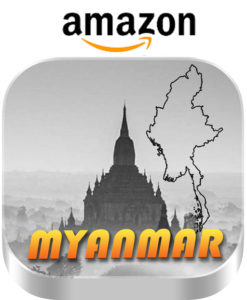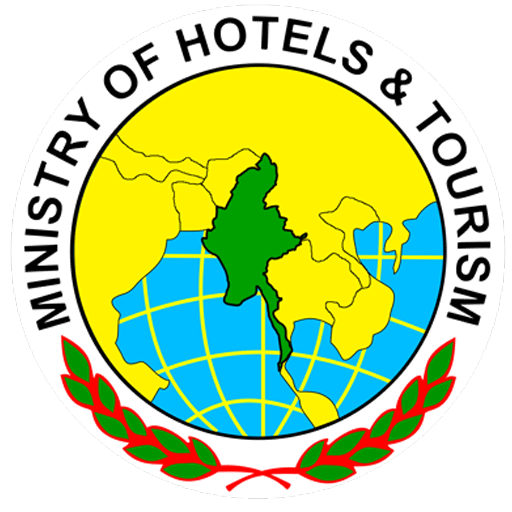Festival in Myanmar
Discover exciting festivals that represent Myanmar’s rich culture, traditions and customs. Each festival is made memorable and fun by the whole hearted participation of locals. Join them in their celebrations and witness beautiful parades of offerings, lights, hot air balloons and even interesting performances in the festivals of Myanmar.
IN JANUARY
 ANANDA PAGODA FESTIVAL, BAGAN
ANANDA PAGODA FESTIVAL, BAGAN
4 – 9 Jan
The Ananda Pagoda Festival is held from 4 – 9 January. The entertainment includes Zats: A colourful round dance with singing, short and long theatre performances; Anyeints: open-air performances lasting several hours, during which comedians caricature current events.
Traditional dances and popular films are shown in between. During the festival, there is also a popular market that takes place, where a variety of items and many local products are sold. An interesting feature of the festival is the caravan of ox carts on the grounds of the pagoda situated under the shade of trees. The most popular time to visit the festival is full moon day, on the 9th January.
 KACHIN MANAW-FESTIVAL, MYITKYINA
KACHIN MANAW-FESTIVAL, MYITKYINA
9 – 10 Jan ( Festival Places & Duration need to update)
Kachin is one of the states that hosts a wonderful festival known as Manaw. The Kachin, the mountain people or the ‘The Scottish People of Burma’ celebrate the Manaw festival. It is one of the most popular festivals in Myanmar.
This festival has been held for more than three decades. The different versions of the Manaw festival celebrate the New Year, battle victories, the reunification of tribal groups and much more. Everyone in the town gets involved in the spiritual dance, in which people form a line one behind the other.
The traditional Manaw columns are decorated with strikingly colourful Kachin images. They are located at the centre of the festival site. All those who come to the festival wear their best traditional dress. The main activity at the festival is the dance around the erected Manaw columns, very similar to the totem poles used by North American Indians. The Manaw festival takes place in Myitkyina and Putao, in the state of Kachin.
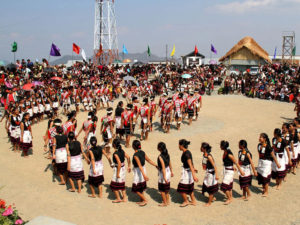 NAGA NEW YEAR FESTIVAL, SAGAING DIVISION
NAGA NEW YEAR FESTIVAL, SAGAING DIVISION
12 – 16 Jan
In Kham-Ti and the surrounding villages of Kham-Ti, the annual Naga New Year’s Festival is held from 12 – 16 January. On 12 January, there is the opening ceremony of the Naga New Year Festival with various competitions and traditional sports, along with the coming together of the Naga subtribes.
These were once feared warriors in their bright and exotic festival costumes, celebrating with rice wine and grilled meat and accompanied by ancient tribal dances and a loud drumbeat.
MAHAMUNI-PAGODEN-FEST, MANDALAY
25 Jan – 8 Feb
The festival falls on the full moon day of Thabodwe and, as a rule, lasts for 14 days. Competitions are also held on the pagoda platform for the production of sticky rice (a delicacy in Myanmar). On the full moon day (8 February), a variety of incense sticks are lit in front of the Mahamuni pagoda.
During these festivals, thousands of visitors make the pilgrimage to the Mahamuni pagoda. The pagoda is always the centre of activities. On a full moon day it explodes with energy. Evening entertainment like Zats (a variety of dances, song and short theatre performances) and Anyeints. The event lasts for several hours. Comedians also poke fun at current events. The event is broken up by traditional dances and open-air films. During the day, Burmese snacks are sold on small stands.
NYAN TAW PAGODA FESTIVAL (SHWE MYIN-ZINN-PAGODE), MAYMYO (PYIN OO LWIN)
31 Jan – 8 Feb
Similar to other pagoda festivals. It is one of the most popular festivals in Maymyo. Shan and other ethnic groups descend from the hills during the festival, to visit the festival or to buy its products.
IN FEBRUARY
 GOLDEN HILLTOP FESTIVAL, KYAIK KHAUK PAGODA
GOLDEN HILLTOP FESTIVAL, KYAIK KHAUK PAGODA
3 – 9 Feb
The Kyaik Khauk Pagoda Festival takes place from 3 – 9 February. Local produce, ceramic and all sizes of pottery items are available to buy at the many stands, along with furniture and bamboo mats. As with the majority of pagoda festivals, there is colourful evening entertainment on offer with Zats, Anyeints and stage shows. The locals from the surrounding area mostly arrive just before the full moon day (8 February) with their ox carts.
IN MARCH
 INDAWGYI FESTIVAL, HOPIN, IN MYITKYINA
INDAWGYI FESTIVAL, HOPIN, IN MYITKYINA
1 – 8 March
Located approximately 200 km from Myitkyina, approx. five hour drive to Indawgyi. The festival is celebrated every year over 10 days. One impressive feature is the two sandbanks, which appear from the lake just in front of the festival, allowing people to pass from the riverbank to the pagoda. The locals reserve a sandbank for the people.
The second passage is meant for the gods. Shortly after the festival, both sandbanks disappear again into the water.
 BAW-GYO FESTIVAL, IN HSIPAW / SHAN STATE
BAW-GYO FESTIVAL, IN HSIPAW / SHAN STATE
3 – 8 March
Once a year and only during the festival days, the four figures of Buddha which are otherwise kept behind closed doors are brought out and newly gilded with gold leaf. There are products on sale from the tea-growing Palaung tribe and jewellers from Kyauk Me. Gambling, which is otherwise forbidden, is permitted during the festival.
PINDAYA CAVE FESTIVAL, PINDAYA
6 – 8 March
During the festival at the Shwe Oo Min Pagoda Cave in Pindaya, thousands of believers besiege the cave to pay homage there. Hundreds of little stands offer delicious local food, Shan handicrafts, all types of ‘cheroots’ (Myanmar cigars), Shan umbrellas and much more. Diverse ethnic groups from across the Shan state visit the festival in their traditional costumes.
KEKKU PAGODA FESTIVAL, TAUNGGYI
6 – 8 March
On the full moon day (8 March), the indigenous Pa-O come to give alms, dressed in their traditional black costumes. There is also a market during the festival days.
NA WIN TAUNG PAGODA FESTIVAL, MAYMYO (PYIN OO LWIN)
8 March
A traditional Shan festival approximately one hour’s drive north of Maymyo.
SHWE SARYAN PAGODA FESTIVAL, SHWE SARYAN-DORF, PATHEINGYI, MANDALAY
8 – 16 March
45 minute journey from Mandalay, in the direction of Maymyo (near Hton Bo). A small boat can be hired to cross the Douhtawaddy River and view the surrounding pagodas. Traditional toys, baskets and mats made from rice straw are sold during the festival.
 AH-LONE FESTIVAL, NEAR MONYWA
AH-LONE FESTIVAL, NEAR MONYWA
11 – 16 March
On the road to Shwe Bo, 12 km north of Monywa, the town of Ah-Lone celebrates its festival in March. The heroine of the festival is Ma Ngwe Daung (Ms. Silver Wings) who was a daughter of the Ah-Lone Bodaw (a minor Indian prince who came through Tamu and Kaleitmyo to Myanmar). The celebration of this festival is related to the love story of Ma Ngwe Daung. During the festival, the pilgrims turn to Ma Ngwe Daung to ask for the opportunity of having as many mistresses as they have hairs on their head. The festival also draws in pilgrims who are wishing for good health or who want to overcome an illness through the power of magic.
MAUNG DONG NAT FESTIVAL, MONYWA
13 March – 23 March
This festival is known as the most important gathering of witches imaginable. Legend has it that Ye Kin Kadaw, the Queen of witches and the favourite wife of King Taung U, had extraordinary powers. The king sent her into exile because her supernatural power was not liked by his other wives. She went to Maung Dong where she was drowned. Her oldest statue, only 30 cm high, can be visited in Maung Dong. During the festival, all 37 ‘Nats’ are placed in a shrine. Devotees offer whole bunches of bananas, green coconuts, betel beliefs, colourful arrangements of flowers and money.
IN APRIL
SHWEMAWDAW PAGODA FESTIVAL, BAGO
2 – 11 April
It is similar to the other festivals, with typical evening entertainment involving Zats, Anyeints and stage shows. Typical Myanmar goods and everyday household items are sold at the market stalls around the pagoda.
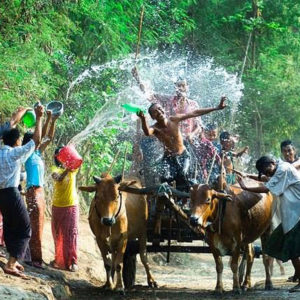 THINGYAN WATER FESTIVAL (THROUGHOUT MYANMAR)
THINGYAN WATER FESTIVAL (THROUGHOUT MYANMAR)
12 – 17 April
Before the Burmese New Year is celebrated, the three-day water festival is held. From morning to night, it is mostly young people who splash and pour water over one another, while elder people retreat into the monastery. There are copious celebrations for three days. People travel in open top cars through the city. There are many stages along the streets, where not only traditional dances are performed. Almost everything is closed during the festival days: restaurants, businesses, markets, museums etc.
On Burmese New Year’s Day, the people of Myanmar visit family and go together to the pagoda.
POPA CEREMONY, MT. POPA
21 April
Nat dances on Mt. Popa. It is very crowded and difficult to get up the mountain.
IN MAY
SAND STUPA FESTIVAL, PA LE NGWE YAUNG QUARTER / MANDALAY
1 – 6 May
Over the course of one night, stupas are built from sand in three different districts of Mandalay. A stupa consists of five parts which are positioned above one another and supported by bamboo mats and posts. Every district holds its building ceremony on a different date.
SAND STUPA FESTIVAL, YAHAI QUARTER / MANDALAY
1 – 6 May
Over the course of one night, stupas are built from sand in three different districts of Mandalay. A stupa consists of five parts which are positioned above one another and supported by bamboo mats and posts. Every district holds its building ceremony on a different date.
SAND-STUPA-FEST, MIN THAR SU QUARTER / MANDALAY
1 – 6 May
Over the course of one night, stupas are built from sand in three different districts of Mandalay. A stupa consists of five parts which are positioned above one another and supported by bamboo mats and posts. Every district holds its building ceremony on a different date.
SHWE KYET YET EVENT, AMARAPURA
3 – 6 May
Believers crowd around to pour water on the sacred Bohdi tree.
SHITE-THAUNG PAGODA FESTIVAL, MRAUK OO
3 – 6 May
These pagoda festivals take place from 3 – 6 May. The most important day is the 6th May (full moon day). It is the same as other pagoda festivals with one exception: the traditional boxing show.
THI-HO-SHIN PAGODA FESTIVAL, PAKOKKU
31 May – 5 June
This pagoda festival takes place from 31 May – 5 June. Throughout the event, there is a market and evening entertainment with Zats, Anyeints and movies.
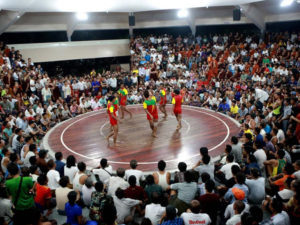 CHIN-LONE FESTIVAL, MAHAMUNI / MANDALAY
CHIN-LONE FESTIVAL, MAHAMUNI / MANDALAY
25 June – 5 July
The Chin Lone (a ball made of bamboo or rattan) tournament is held in Mandalay, on the site of the Mahamuni Pagoda. Players from all parts of the country take part in this event. The aim of this ball game is to keep the ball in the air for as long as possible without using your hands. The players have had tremendous practice at this game and their acrobatics never cease to amaze onlookers. The games are accompanied by native music.
IN JULY
IN AUGUST
 SHWE KYUN PIN NAT PWE MINGUN (NAT FESTIVAL IN MINGUN), MANDALAY
SHWE KYUN PIN NAT PWE MINGUN (NAT FESTIVAL IN MINGUN), MANDALAY
21 –26 Aug
This festival is celebrated in the Myanmar month of Tabaung. According to legend, the youngest brother of King Mindon prevented a rebellion and was able to successfully drive out the Prince of Hsipaw. Some of his six children were killed in this confrontation. Mindon’s brother did not rest until all possible successors to the principality of Hsipaw had been eliminated. One day, when visiting a boat race in Thit Maik Myun, two of his surviving children were hit by a wooden trunk and drowned in the Shweli River. Their mother died from heartbreak at this loss. The ‘Pagoda of Despair’ (Lwan Hpaya) was built at this location. The children who drowned were declared ‘Nats’ and, from this time onwards, became the keepers of the river. After harvest time, hundreds of farmers dressed in brightly-coloured clothing come with their beautifully decorated ox carts to the Myatheindan Pagoda and erect a large tent as a temporary home for the Nat images. During this time, the mediums perform Nat dances in order to bring a good harvest for next year. The spectacle is accompanied by hundreds of spectators.
 TAUNG BYONE NAT FESTIVAL, TAUNG BYONE VILLAGE NEAR MANDALAY
TAUNG BYONE NAT FESTIVAL, TAUNG BYONE VILLAGE NEAR MANDALAY
26 Aug – 2 Sep
The Taung Byone Nat or Spirit Festival is a very popular celebration, which is held during the rainy season (July-August). Taung Pyone is situated about one hour’s drive north of Mandalay. The homage celebration is now held annually, to appease the spirits, as it is believed that the Nats can make wishes come true, protect against illness and danger and bring their worshippers wealth and success. According to legend, two Indian brothers named Byat Wi and Byat Ta received extraordinary powers after eating the body of a dead alchemist. Byat Wi, the older brother, lost his supernatural power after walking under a clothesline on which women’s skirts used in childbirth had been hung. He was captured and killed after his mistress had offered him a betel nut and a glass of water. Byat Ta was killed by King Anawrahta’s magical lance after returning late for the third time with fresh flowers from Mount Pop for the royal audience. As a result, his wife Popa Medaw died of a broken heart.
15 years later, the two sons of Byat Ta and Popa Medaw, who were adopted by King Anawratha, each forgot to bring a brick to be used for building the ‘Pagoda of Wishes’. King Anawratha soon found out who was responsible for the two missing bricks and gave the order to hit them gently with a fillet stick. The trap, which been planned all along and set by the king’s son Kyansittha, meant they were beaten instead with bamboo sticks and died. Hundreds of mediums (Nat-Kadaw) and thousands of pilgrims come once a year to Taung Byone, where the statues of the two brothers are erected in a shrine. The ‘Pagoda of Wishes’ remains there to this day with the two missing bricks. It is the most impressive Nat festival in Myanmar. Offerings and dances, the flow of traders, the constant arrival of pilgrims and the intense sound of loudspeakers accompany both day and night.
IN SEPTEMBER
YADANA GU NAT FESTIVAL, AMAPURA NEAR MANDALAY
10 – 16 Sep
Known as the Mother of the Taung Byone Festival. The short trip by rowing boat to the festival site is entertaining. The festival is held every year in honour of Mount Popa Medaw, Mewanna (mother of the two lords) who, on her return from the Taunbyon Festival to Mount Popa, established a transit camp in Yadanagu.
IN OCTOBER
BO BO GYI NAT FESTIVAL, TAUNGTHAMAN NEAR MANDALAY
5 – 11 Oct
It is said, that Bo Bo Gyi was a highly respected alchemist. He is now honoured as a Nat. In Armarapura, near Taungthaman Lake, over which the famous U Bein Bridge runs, pilgrims get together every year for this festival. Pilgrims throw small packets of tea leaves at one another. It is said, that whoever is hit must also visit the festival next year.
 PHAUNG DAW OO PAGODA FESTIVAL, INLE LAKE
PHAUNG DAW OO PAGODA FESTIVAL, INLE LAKE
17 Oct – 3 Nov
The most famous festival at Inle Lake. The images of Buddha from the Phaung Daw Oo Pagoda are paraded around the lake on a ceremoniously decorated barge. They stop at every village to give believers the opportunity to pay homage. The festival is colourful and full of traditional influences. Traditional dances and boat races are held – there is something here for everyone. The festival normally lasts up to three weeks. For the programme of events for the Paung Daw Oo Pagoda Festival please click here.
KYAUKDAWGYI PAGODA FESTIVAL, MANDALAY
27 – 31 Oct
At the foot of Mandalay Hill, just a short walk away from Mandalay Hill Resort Hotel. This is a very popular selling event, where many handcrafted products are sold and an entertainment programme is held just like at nearly all other pagoda festivals.
INDEIN PAGODA FESTIVAL, INLE LAKE
27 – 31 Oct
A Buddhist festival, which is held in the shrine complex of Indein, an only recently rediscovered area of ruins with countless pagodas built in both the Bagan and Shan styles.
ELEPHANT FESTIVAL, KYAUKSE NEAR MANDALAY
30 Oct – 1 Nov
This unique and exotic festival of dancing elephants is the annual high point of Kyaukse, which is located approximately 50 km south of Mandalay. The entire town takes part in the competition, in which it is not just about the best ‘elephant dance’, but also the most beautifully decorated ‘elephant’. As part of the dance, two men hide within a life-size elephant made from papier mâché and sing and dance while accompanied by music.
THADINGYUT FESTIVAL OF LIGHTS (THROUGHOUT MYANMAR)
30 Oct – 1 Nov
TheThandingyut or Festival of Lights is celebrated across the country. It begins one day before full moon and ends after three days. Houses and streets are beautifully illuminated. The nation’s pagodas are very crowded. It is not only a festival of joy, but also a time to give thanks to parents and teachers, and to ask those who you wronged during the year for forgiveness.
IN NOVEMBER
KAUNG-HMU-DAW PAGODA FESTIVAL, SAGAING
22 – 30 Nov
One particularly interesting aspect is the sight of the caravan of ox carts loaded with local goods such as handwoven cotton, rice mats and cane mats as they temporarily occupy the pagoda grounds, under the shade of the trees.
 BALLOON FESTIVAL, TAUNGGYI
BALLOON FESTIVAL, TAUNGGYI
23 – 29 Nov
The Hot Air Balloon Festival is celebrated once a year on the second Festival of Lights after Buddhist Lent, and lasts for four days. Traditionally, it is the festival in which the natives pay homage at the Sulamani Temple by releasing decorative balloons towards the heavens. The paper balloons are between 4, 5 and 6m high, and are decorated on the outside with colourful lanterns made of cellophane. Lights are attached to the lanterns, giving the balloons a different pattern. The hot-air balloon rises quickly because of the flame heating the air inside the balloon – a 3 to 5m long trail with various fireworks being dragged along behind which constantly explode. Take a look at how the small children’s balloons are made, along with the competition between the different groups, for whom it is all about the most beautifully decorated and the highest ascending balloon. For the programme of events for the Hot Air Balloon Festival please click here.
SHWEZIGON PAGODA FESTIVAL, BAGAN
26 – 29 Nov
The Shwezigon Festival takes place from 26 to 29 November. The entertainment includes Zats: A colourful round dance with singing, short and long theatre performances; Anyeints: open-air performances lasting several hours, during which comedians caricature current events. Traditional dances and popular films are shown in between. On the full moon day (29 November), there is a communal offering of food to the monks. Up to 600 monks arrive here from the surrounding monasteries.
TAZAUGDINE FESTIVAL OF LIGHT (THROUGHOUT MYANMAR)
28 – 29 Nov
A colourful gathering, during which the monks are offered yellow robes and other everyday household items. This gift giving ceremony is known by the name of ‘Kathein’. Every Buddhist regardless of status wants to take part in this at least once in their lifetime. Sagaing in particular is a big attraction for believers, as it offers a unique concentration of monasteries and pagodas in the surrounding area.
THANBODDE PAGODA FESTIVAL, MONYWA
28 – 29 Nov
Just like other pagoda festivals with the typical entertainment. Myanmar Thanaka, sandalwood and woven textiles (predominantly cotton sheets and longyis) can be bought from the various stands surrounding the pagoda grounds.
PHO-WIN-TAUNG FESTIVAL, MONYWA
28 – 30 Nov
It is similar to the other festivals, with typical evening entertainment involving Zats, Anyeints and stage shows. Typical Burmese goods are sold on the market stalls surrounding the pagoda such as Thanaka, sandalwood and handwoven textiles.
SHIN MAR LE PAGODA FESTIVAL, THAZI
28 Nov – 2 Dec
It is celebrated during the Tazaung Dine Festival. In honour of Buddha, believers throw lotus flowers at the top of the stupa, which is located at the north entrance of the Mahamuni Pagoda.
ROBE WEAVING CONTEST (THROUGHOUT MYANMAR)
29 Nov 2020
The rope weaving contest is held on the evening before the full moon. In this competition, teams of women compete from dusk til dawn for the title of most skilled weaving team of the saffron-coloured ‘Ma Tho Thin Gan’ robes. The weaving is performed in traditional style. The skill and handicraft of the various teams is a feast for the eyes. The finished robes are presented to the Bhudda at daybreak. The prize is then awarded for the most beautiful robe.
KYAIKHTIYO PAGODA FESTIVAL, GOLDEN ROCK
29 Nov 2020
The Kyaikhtiyo Pagoda is one of the most sacred sites in Myanmar. Zats and Anyeints are performed to entertain the people. Zats consist of dance, song and theatre performances. The Anyeints are performances by comedians, which are broken up by dance and film screenings. Small bamboo huts are erected, where traders sell their goods. At midnight, 9,999 candles are lit.
SHWEMYETMHAN PAGODA FESTIVAL, SHWE TAUNG NEAR TO PYAY
22 – 29 Dec
This festival is similar to other pagoda festivals. With one exception: During British colonial times, the wife of a police commissioner, Mrs Hurtno, was cured of an eye disease when she offered Bhudda a pair of glasses. It has since become customary amongst natives to offer gifts to this Bhudda when suffering from eye diseases.
 MOUNT POPA NAT FESTIVAL, MOUNT POPA
MOUNT POPA NAT FESTIVAL, MOUNT POPA
29 Dec
Mount Popa is certainly the most important Nat places of worship in Myanmar. Thousands of pilgrims from the rural areas and cities delight in participating in this festival. In former times, animals were sacrificed and offered to the Nats. However, since the Bagan Dynasty, such practices have been forbidden. Spirit processions and drunken ecstasy are all part of the celebrations.



